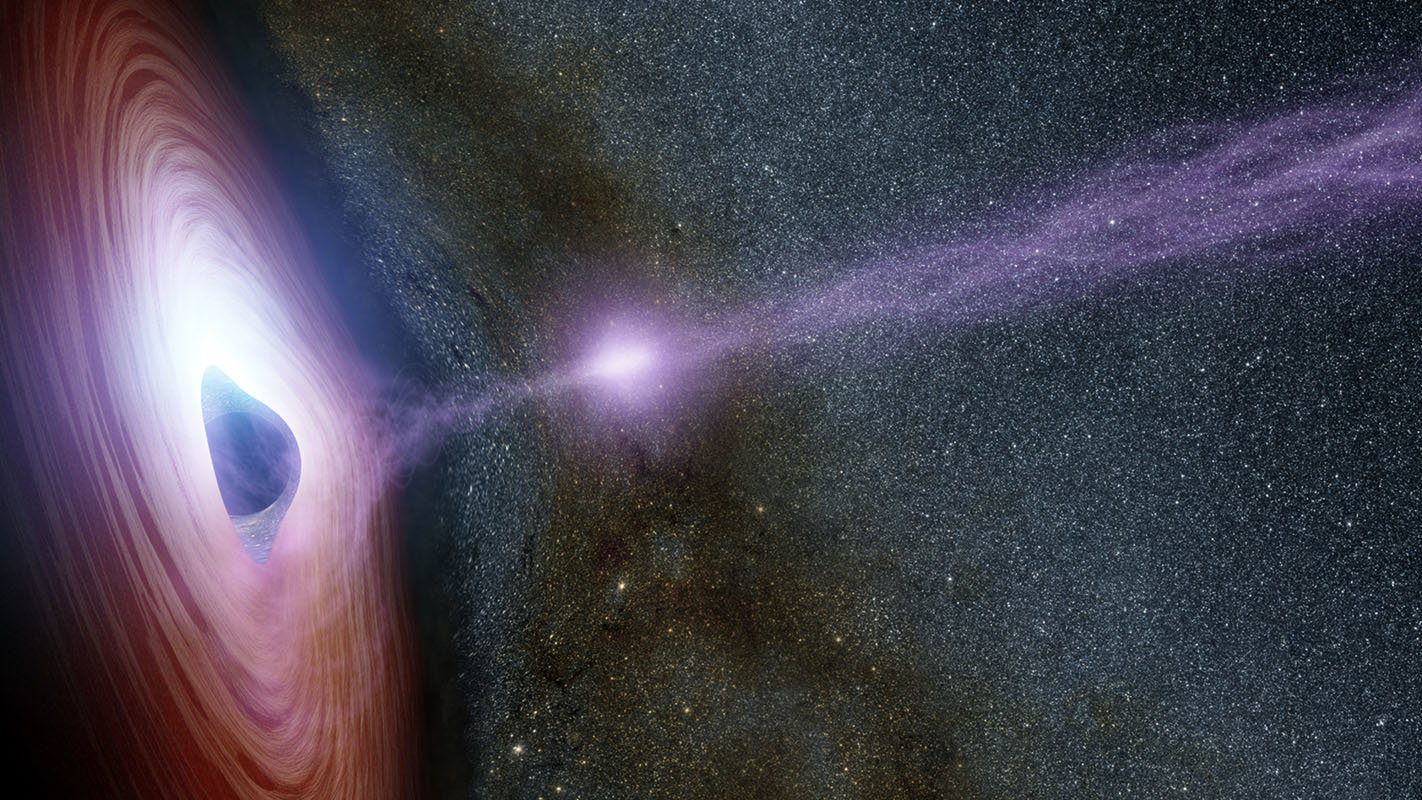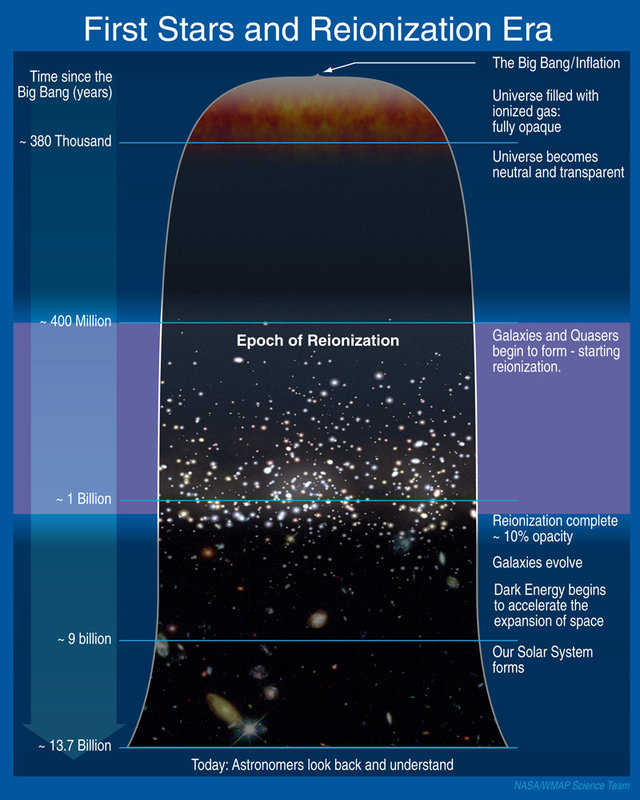
How was light able to burst out of the gloom of the cosmic "dark ages," approximately 500 million years after the Big Bang? New research may provide insight into one of the universe's longest standing mysteries, and the surprising hero in this story might be everyone’s favorite astronomical villain: black holes.
The story starts within the fractions of a second after the Big Bang, when the universe expanded exponentially. It became a cosmic soup of fundamental particles that cooled relatively quickly in about 400,000 years, creating a dense hydrogen gas. This began what is known as the cosmic dark ages, during which the universe was shrouded in murk.
Any light emitted by early stars and galaxies would have been almost immediately absorbed by the surrounding thick neutral hydrogen medium. But somehow, the intergalactic medium changed from being cold and neutral to become warm and ionized.
Cosmologists have theorized that enough intense ultraviolet light was produced by early stars and galaxies to burn off the dense hydrogen, sparking the epoch of re-ionization that transformed the universe into the light-filled marvel we know today.
How this happened is not well understood, as other theories say the UV radiation from the stars and galaxies in the dark ages would not have been powerful enough to blow through the neutral hydrogen.
But a new study of recent observations by the Chandra X-ray Observatory, whose results were just published in the journal Monthly Notices of the Royal Astronomical Society, might provide a clue.
RELATED: Hubble Has Found the Ancient Galaxies That Gave the Universe Its First Light
Get the Space.com Newsletter
Breaking space news, the latest updates on rocket launches, skywatching events and more!
While black holes are famous for devouring all the light and matter around them, some of them are known to be spitting out powerful jets of high-energy x-ray particles.
"As matter falls into a black hole, it starts to spin and the rapid rotation pushes some fraction of the matter out," said lead author Philip Kaaret, from the University of Iowa, in a statement. "They're producing these strong winds that could be opening an escape route for ultraviolet light. That could be what happened with the early galaxies."

Kaaret and his team looked at Chandra data from a galaxy called Tol 1247-232, located about 600 million light years from Earth. It is one of only three nearby galaxies from which ultraviolet light has been found to escape. In May 2016, Chandra observed a single X-ray source from Tol 1247-232 whose brightness waxed and waned. Kaaret and his colleagues determined the source couldn't be a star.
"Stars don't have changes in brightness," said Kaaret. "Our sun is a good example of that. To change in brightness, you have to be a small object, and that really narrows it down to a black hole."
Jets of X-ray material shooting out from the black hole appear to have blown out cavities in the nearby gaseous medium, allowing the UV light to escape.
"It's possible the black hole is creating winds that help the ionizing radiation from the stars escape," Kaaret said. "Thus, black holes may have helped make the universe transparent."
RELATED: This Is Our Amazing Technicolor Cosmos
He compared the process to a figure skater spinning with outstretched arms. As the skater brings her arms closer to her body, she spins faster. Black holes operate in a similar fashion. As gravity pulls matter inward toward a black hole, the black hole likewise spins faster. As the black hole's gravitational pull increases, the speed also creates energy.
As in Tol 1247-232, the blasts of X-rays in the early universe would have had enough heat and energy to blow the neutral gas and dust away, the team said, allowing the ultraviolet radiation to "leak" out.
Kaaret explained in an email to Seeker that many of the early stars in the universe were massive.
"These stars age very quickly and die as black holes," he wrote. "The stuff around black holes is very hot (millions of Kelvin) and creates X-rays. Then the UV in the story comes from hot stars, and is 10,000s to 100,000s of Kelvin."
RELATED: Astronomers Are Attempting to Capture the First-Ever Photograph of a Black Hole
While black holes are the likely mechanism, the team would like to narrow down the type of black hole. They also said there are still other possibilities to explain their observations.
"Another possible origin of the X-ray emission," the team wrote in their paper, "is from an ultraluminous (ULX) or hyper-luminous (HLX) X-ray source. ULXs are thought to be X-ray binaries that contain stellarmass black holes or neutron stars. HLXs may be super-Eddington accretors [possibly quasars] or intermediate mass black holes."
They said that repeated X-ray imaging of Tol1247 with Chandra could reveal whether the X-ray emission arises from a single source or multiple sources. Additionally, the team has been looking at a similar galaxy, Haro 11, and said that since "it is not possible to draw robust conclusions from a sample of two objects," they hope to be able to observe more galaxies where jets of material shooting out have blown out large cavities in the surrounding gas.
Originally published on Seeker.
Join our Space Forums to keep talking space on the latest missions, night sky and more! And if you have a news tip, correction or comment, let us know at: community@space.com.

Space.com is the premier source of space exploration, innovation and astronomy news, chronicling (and celebrating) humanity's ongoing expansion across the final frontier. Originally founded in 1999, Space.com is, and always has been, the passion of writers and editors who are space fans and also trained journalists. Our current news team consists of Editor-in-Chief Tariq Malik; Editor Hanneke Weitering, Senior Space Writer Mike Wall; Senior Writer Meghan Bartels; Senior Writer Chelsea Gohd, Senior Writer Tereza Pultarova and Staff Writer Alexander Cox, focusing on e-commerce. Senior Producer Steve Spaleta oversees our space videos, with Diana Whitcroft as our Social Media Editor.









